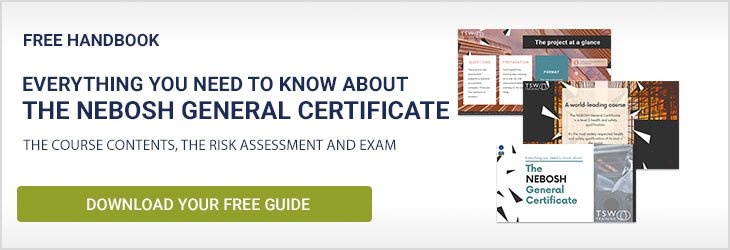You must pass the new NEBOSH open book exam to achieve your NEBOSH National General Certificate In Occupational Health And Safety qualification.
The exam asks you to resolve a risky scenario using what you’ve learned, applying elements one to four in NG1. You must also have a live closing interview to discuss your answers.
Key points:
- The new exam is a remote test for NG1. Log in to the NEBOSH exam platform and complete the assessment from home, or a safe space of your choice.
- You have 24 hours to complete the exam. NEBOSH suggests it’ll take you between four and five hours to complete the questions, so you should spend the rest of the time researching and drafting your responses.
- The questions ask you to apply theoretical knowledge to real-life health and safety situations. You must also pass the NEBOSH practical risk assessment to gain your qualification.
Download your free guide to the NEBOSH General Certificate

Meet the new-look NEBOSH open book exam
The new open-book exam (OBE) replaces the old paper-based invigilated exam. It was created to protect NEBOSH learners during the COVID-19 pandemic. It builds and improves on the old assessment.
- You have more time to complete the exam, with room to give thorough and detailed responses while consulting your textbooks.
- The OBE focuses on the real-world application of NEBOSH health and safety theory. Although you can use your books, you won’t pass simply by restating the facts within them.
- You are presented with a real-life risky workplace scenario and you’re assigned a role in the situation, like a site safety supervisor.
- The scenario is followed by a series of questions, tasks and sub-tasks that give you the chance to demonstrate your knowledge. For example “How could you improve consultation with the workforce in the organisation described?”
- You look for evidence within the scenario and reflect on what you’ve learnt to inform your answers.
- You can take your exams from home, or a safe location of your choice, limiting your exposure to other learners and invigilators.
- In some instances, where it’s safe to go so (and provided the local government gives its permission), some training centres can host invigilated in-person exams, but it’s not likely to be until later this year.
- It promises the exam will still represent ‘the quality and standards NEBOSH qualifications are known for’ and that they won’t be compromised.
24-hours on the clock
You have 24 consecutive hours to complete and upload the paper for submission. Unfortunately, if you submit the paper after the 24-hour deadline it won’t be marked and you’ll fail the exam. It’s worth setting an alarm an hour before so there are no nasty surprises after all that work.
NEBOSH suggests it’ll take you between four and five hours to complete the paper. It gives you plenty of time to draft your answers and navigate unexpected exam potholes, like an internet outage or power cut.
Use the extra time to interpret the scenario and establish your role within it, then research and gather relevant evidence to give weight to your answers.
And although it’s a longer exam and you’re not being watched, that doesn’t imply it’s a more laid back experience.
Here are some tips to help you complete the exam:
- The NEBOSH General Certificate exam keeps you under exam conditions for a long time. You’re under pressure, but resist rushing through the paper just to get it in and done quickly.
- Plan your time beforehand, because leaving everything to the last minute will allow mistakes, or poorly evidenced claims, to creep into your work.
- Now is the time to be precise. Plot your time so you have room to draft and review your work before submitting the final version. Go in calmly and take a methodical approach.
Is the Open Book Exam (OBE) easier than the old assessment?
NEBOSH expects you to be detailed, taking advantage of the open book element to evidence your responses.
It’s not an easy option. OBEs ask you to think critically about what you’ve learned, discuss them fully, shear off the irrelevant information and apply the appropriate principles.
The OBEs are a step change for NEBOSH which, until the COVID-19 lockdown, would usually ask you to attend a two hour invigilated exam to get your qualification.
It’s a positive change for learners:
- If you’ve avoided the NEBOSH National General Certificate (NGC) because you fall to pieces in exams, the open book assessment lets you work in a more real to life scenario, whereby you are able to take time to observe a situation and research the best ways to deal with it
- You have more time to formulate your answers and deepen your situation-specific understanding of NEBOSH principles
- If you started training pre-lockdown, or you’ve been stopped from sitting the exam due to social distancing risks, the open book test prevents further delays
The NEBOSH OBEs are a major forward step forward for the General Certificate course. In making this move, NEBOSH is showing its commitment to innovation, while maintaining assessment standards. OBEs will make the qualification more accessible for those who struggle with examinations – that’s most of us!
The examinations will simulate a real working situation, where research and application of knowledge to address a particular situation or goal is what makes for great health and safety management.
What is in the exam?
The exam will present a health and safety scenario for you to resolve. It will contain information like:
- The workers involved, their roles and their individual challenges
- Conflicting opinions, employee disagreements and working relationships influencing the situation as it unfolds
- The physical features, surroundings and area you’re working in
- The actions you’ve already taken
- Existing health and safety issues, for example, the omission of formal procedure
*There is a word count limit with 10% leeway either way. The surplus work won’t be marked, so make sure you keep track of how much you’re writing.
a) What to expect from the tasks
The tasks ask you to demonstrate your understanding of NEBOSH health and safety principles by rectifying the problems within the scenario. You could be asked to:
- Collate arguments for a health and safety committee meeting
- Counter flawed recommendations provided by a peer or superior
- Comment on the culture of the business
- Schedule and justify the need for health and safety focus groups and regular meetings
But that’s not an exhaustive list. The questions could focus on anything in the NEBOSH National General Certificate syllabus, so you need to know your onions before you attempt to answer the question.
You have 24 consecutive hours to complete and upload the paper for submission.
b) Question themes
The new question paper tests what you know about health and safety – you have to apply theoretical knowledge to workplace situations.
These themes might crop up during the exam:
Element one questions: Managing workplace health and safety
In element one, you cover the basics of workplace health and safety. It’s health and safety from a compliance and management perspective.
The exam questions could ask you about:
- The financial cost of accidents and incidents
- The moral implications and expectations of good health and safety
- Relevant acts of parliament, regulations and codes of practice
- Negligence, duty of care and liability
- Health and Safety at Work Act 1974, sections 2-4, 6-9 and 37
- Management of Health and Safety at Work 1999 Regulations, sections 3-5, 7, 8, 10 and 13-14
- How to pick and manage contractors
- How to plan and manage contracted work
- The role of clients, principal designers, principal contractors, workers and domestic clients under the Construction (Design and Management) Regulations 2015
- HSE notifications, pre-construction information and construction phase plans
Element two questions: How health and safety management systems work and what they look like
Element two moves onto the setup and success of a health and safety management system.
It covers how one can be used to improve an organisation:
- What are the requirements for a health and safety management system (ISO 45001:2018)?
- How HSG65 – the Plan, Do, Check, Act model for health and safety management systems – helps you to comply with the law
- How to set objectives and targets, using specific, measurable, achievable, reasonable and timely (SMART) principles
- How to identify the organisation’s technological, financial, operational and business requirements
- Defining the roles, structure and responsibilities of your people in the organisation
- How to keep the health and safety system practical and current
Element three questions: Managing risk, understanding people and processes
In element three, you’ll look at the various types of risk assessment and what a good health and safety culture looks like:
- An organisation’s health and safety culture indicators, for example, incidents, sickness, turnover and complaints
- How to improve health and safety culture by enhancing communication, promoting better standards, using disciplinary procedures, hiring competent workers and improving training
- The human factors that will influence the health and safety culture, like organisational, job, individual factors
- The significance of assessing risk and what’s involved with the risk profiling process
- How to identify risks, people at risk and evaluate risk
- Specific and specialist risk assessments, for example, fire, DSE, manual handling and noise
- How to safely manage change, thinking about communication, risk assessments, and reviews
- How to develop a safe system of working and monitor it
- What are technical, procedural and behavioural controls when you’re looking at safe systems of work?
- Permit-to-work systems – what they are, why they’re used, how they’re used and when you should use them
- What emergency procedures and training should an organisation employ?
- What are the considerations when planning first aid measures? For example, shift patterns, site location and number of workers
Element four questions: Health and safety monitoring and measuring
Element four shows you how to watch over the processes and changes you’ve made, so you can adjust policies and processes based on real-world findings and data.
The exam questions might ask you about:
- Active versus reactive monitoring and the use of each in various situations
- Minimal, low, medium and high incident investigation, plus how to gather, analyse, identify the risk and your plan of action
- How you’d record and report diseases and dangerous occurrences
- How to audit your health and safety management system and what to do if it fails
- Reviewing your health and safety performance looking at absence and sickness reports, sampling, accident data and objectives met, to name just a few
- Making recommendations for continuous improvement
c) What supporting materials can you use?
You can use the internet and your textbooks to formulate your answers. Just use your own words.
NEBOSH recommends your personal notes from the course are good sources of supporting information for the OBE.
You can also look for info on- or offline in textbooks or journals (just make sure they’re recent and relevant to the current NEBOSH General Certificate syllabus).
There are some restrictions as to what supporting materials you can use, however:
- You must not speak to your NEBOSH trainer, your classmates, or anyone that works at TSW, about the topic of the assessment
- Ask for help and input from anyone else, including proof-readers, friends and family
In this new chapter of digital assessment, NEBOSH has promised to safeguard against plagiarism and collusion.
The exam is asking you to analyse the situation, evaluate and apply your understanding, not regurgitate the relevant section from your textbook.
You’ll be asked to signpost the reference material you use and it’ll be scrutinised for plagiarism, so keep a note as you work through the paper so you don’t miss any off.
d) What is the pass rate?
There is no pass standard, yet.
NEBOSH will set the pass mark after a number of learners have taken this new OBE.
How to prepare for and pass the NEBOSH OBE
At TSW Training, we’ll guide you to success and train you to the highest standard. As a NEBOSH Gold Learning Provider, you can trust us to steer you in the right direction.
- With the new OBE format, we still recommend that you put in the hours of revision to pass.
- You must revise before taking the paper so you can shift through your notes and textbooks swiftly and make the most of your time.
- That could mean highlighting important passages and putting bookmarks on critical pages.
- Without the prep work, you may lose hours wading through notes and books.
- Have a full and in-the-detail understanding of the syllabus that supports your existing, work-based reasoning.
- You can’t use anecdotal evidence in the exam, so if you can only describe elements of the syllabus with an illustrative story, go back to the books.
Our head of health and safety, Luke Pitt, says success lies in communication: “A great piece of advice is to tell your trainer what you need.
“Many centres just give out paperwork, but I like to see presentations and play learning games. I like to read NEBOSH publications, and more importantly, I want time to discuss.
“For me, bouncing off other people means so much more than reading from a book or death by PowerPoint.”
#1. In lieu of practice papers, make your own
NEBOSH has released a practice paper so you can get a flavour of what’s to come. You can download the UNIT NG1 and NGC1: MANAGEMENT OF HEALTH AND SAFETY paper on its website.
You can create your own mock exams with flashcards and games. Read our revision guide for techniques and ideas.
#2. Answer every question
Answer all the questions as fully as you can, even if the question poses a situation you’re not familiar with. It sounds obvious, but a blank answer won’t get you any marks. Volunteer the information you think apply to give yourself the best chance.
#3. Plan your time
Review the whole paper and take note of where you can get the most marks. Divide up your time so that you’re spending more time on the weighty questions. Be reasonable and realistic with the rest. A question with a greater number of marks is asking for more detail, which will take more time.
#4. Describe, outline, explain
Think carefully about the command word of the question. For example, ‘describe’ versus ‘outline’ or ‘explain’ and respond in a length suitable for the number of marks available. NEBOSH has created a guide that unpicks what its examiners want to see based on the command word of the question.
#5. Work tidily
You can submit a handwritten answer paper. If that’s the easiest way for you to work, your handwriting must be legible and tidy so the examiner can read it.
#6. Stay on-topic and focused
Focus your answer on the question. For example, if you’re asked to identify work-related illness you should report under RIDDOR, don’t list work-related injuries as well.
How to prepare for the closing interview
The closing interview will be a live video call with your trainer or an interviewer nominated by us.
It’s not an assessment.
The interview is necessary so we can chat firstly about the work you’ve delivered – we’ll ask broad and specific questions so you can tell us what you’ve learned during the course.
- It’s a great idea to practice this part with your friends, family or other learners so you get used to speaking about your work and your understanding of the NEBOSH General Certificate syllabus.
- Secondly, we need to prove to NEBOSH that you’ve acted honestly during the open book exam. For instance, that you haven’t plagiarised your answers – even by mistake – or colluded with another learner.
We’ll establish that all the work is yours, with no outside help or intervention.
We’ll also ask you to show us the room you’re in and ask that the camera faces the door throughout your interview.
*Please have a passport, driving licence or national identity card ready to confirm your identity.
NEBOSH would prefer it to be a private interview between you and your interviewer. There are exceptions, like if you are looking after children or if you’re a carer, but you must tell us before the interview so we can notify NEBOSH about the adjustments.
Further reading:
Demystifying the NEBOSH Closing Interview: Top Tips and Insights
Six steps for taking the exam at home
There are six steps to taking the exam at home. It’s really easy, but we’re here to help you at every step.
- We’ll register you for the OBE and you’ll get an email confirmation
- You’ll receive an email containing your login details for the NEBOSH exam platform. You’ll have a username and temporary password to get in initially which you can change once logged in
- Take a tour of the platform so you know where everything is. It auto-plays, so don’t click away
- At 9am on the day of your exam, NEBOSH releases your exam units and answers template to the platform. You’ll see them when you log in and you must download them
- You have 24 hours to complete the paper and you must upload it to the NEBOSH exam platform for submission
- You’ll complete a closing interview to confirm that the work you have submitted is yours and you didn’t have assistance from a third party during the exam
NEBOSH has quality-tested the platform to make sure it works on most browsers and devices.
Log in to the platform a few times prior to your exam. If you do have any problems, there’s plenty of time to get them sorted out. Whichever device you use, it must be able to open a pdf.
If you need support or you’re having trouble accessing the OBE, we’re here to help. The best advice we can give is to:
- Make sure you’re connected to the internet
- Double-check your log in details
- Try typing the password in manually rather than copy and pasting
- Updating the software on your computer
- Experiment with a different browser from the list above
The exam platform is controlled entirely by NEBOSH, so if the above doesn’t solve the issue, we’ll direct you to the live chat on the NEBOSH homepage, or ask you to email [email protected] for help.
Resits for the 2014 syllabus
The OBE replaces the 2014 closed book invigilated exams.
If you’ve passed already of course your qualification will be upheld.
If you studied the old 2014 syllabus, you’ll take the old exam. You’ve got five years to pass the exam from the date you enrolled.
NEBOSH has arranged for an invigilated GC2 on 9 September. You can find out more in the NEBOSH FAQs.
Getting your results
When the exam’s done and your risk assessment has been submitted, there’s nothing to do but wait for your results. NEBOSH advises it can take 50 days for the results to land.
What happens if you fail the exam
- If you get a ‘refer’ that means you haven’t achieved enough marks to pass and you’ll need to re-sit the exam.
- If the ‘refer’ process remains unchanged for the new OBE, you can re-sit the exam as many times as you need to up to five years after you failed.
- The marks aren’t capped if you re-sit. You could fail the first time and get a distinction the second – NEBOSH won’t penalise you for a past fail.
- If you’re having an off-day when you take the exam, you can take it again before you’ve even got your marks back.
- You might be charged a fee, so speak to your training provider if you think you need to resit straightaway.
- If you’ve been unwell, struggled with childcare, or work took over in the lead up to the exam, that gives you flexibility.
Any further questions?
If you’d like to know more about our NEBOSH courses and whether they’re the right course for you and your organisation, take a look at our NEBOSH FAQ page, or get in touch with our team of NEBOSH experts.






